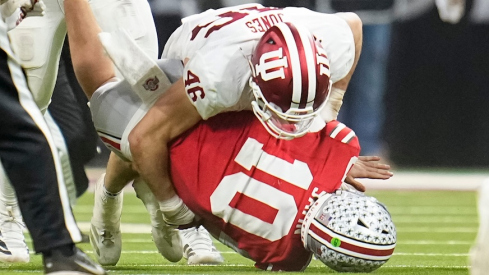Football serves as a game that continues to evolve and surprise its players and appreciators alike in so many different ways. The Ohio State Buckeyes are certainly no stranger to innovation at the college level of the sport, having won the inaugural four-team and 12-team College Football Playoffs on their way to National Championships. But one of the most truly unique accomplishments in football history belongs to former wide receiver David Boston for one of the 34 career touchdowns he scored as a Buckeye.
Ohio State's 1996 game against Pittsburgh remains one that lives fondly in the school's football lore, especially relative to other blowouts when considering the contest ended in a 72-0 romp. The meeting between the Panthers and Buckeyes often finds itself unofficially cited as the core reason former ESPN analyst Mark May harbored such an obvious disdain for Ohio State over the course of his career in media.
Far off from the glory days of May's Outland Trophy-winning campaign in a Pitt uniform, the Panthers traveled to Columbus in 1996 with a 1-2 record that included a 34-0 shutout loss to arch-rival West Virginia in the Backyard Brawl to open the season. Meanwhile, Ohio State planned to emerge from a bye after trouncing Rice 70-7 in the school's home opener a couple weeks earlier.
As the aforementioned final score implies, Pittsburgh rather quickly had its team spirit broken and the game grew out of hand almost immediately. The Buckeyes scored three touchdowns in the first quarter before heading to the locker room with a 52-0 lead at halftime. Boston — merely two games into his freshman season at OSU — captured the second and third touchdowns of his career during the flurry of points after scoring from 58 yards out in the prior game to begin his first season.
But arguably the most impressive touchdown of his entire time in Columbus would take place before the end of the afternoon. As the clock ticked down on a long-decided result, the Panthers once again lined up for a punt with less than four minutes remaining and Ohio State already up 65-0 on the scoreboard.
Pitt had one of its brief moments of success during the game on the Buckeyes' prior offensive series, holding strong for a goal line stand before unsuccessfully moving the ball after the turnover on downs. However, that brief glimpse of willpower would entirely evaporate in short order.
As the special teams units trotted out onto the field, the color commentary team on the broadcast noted that the Buckeyes had only sent out eight players to return the punt. It was an inexplicable and highly irregular brain fart from a team and coaching staff that had otherwise executed to perfection for nearly the entire length of the game.
On rare occasions, a side planning to handle the ball will only run 10 men onto the field of play, usually to an unsuccessful result. More often, defenses will deploy an irregular number of personal onto the gridiron, though usually in excessive capacity rather than shortchanging themselves — just as Dan Lanning.
But only eight players on the field for a team poised to have possession by the end of the down? Such a total seems almost completely unheard of before or since, especially for a program with Ohio State's standards of execution.
However, the Panthers found themselves so beaten down to that point that the shallow quantity of Buckeyes simply did not matter. Boston evaded the first attempt at a tackle before cutting back into the middle of the field to the sheer shock of the television audience.
Before even crossing midfield, Boston's effort elicited a "no..." of disbelief from the commentary booth.
One stiff-arm to the Pittsburgh punter later, Boston had entered the end zone for Ohio State's final score of the day. A reverse end zone replay of the return would confirm the booth's initial observation that Boston had scored with only seven of his teammates serving as potential blockers on the play.
Good luck finding any touchdown in the sport's history at the collegiate level or higher that compares to this instance. It remains a short-handed scoring effort on special teams unlikely to ever find itself replicated due to the sheer calamity of its genesis.
Boston would score just one more punt return touchdown during his OSU career two seasons later in 1998 against Indiana. At the time he departed for the NFL, eventually becoming the eighth overall pick in his draft, he left Columbus with the triple crown of Ohio State career receiving records. Only Emeka Egbuka, K.J. Hill, Michael Jenkins and Chris Olave have since surpassed the great Boston across any of the Buckeye receiver leaderboards for catches, yards or touchdowns.
Yet, despite all those receiving accolades, his doing-more-with-less effort in only the second game of his career stands out as one of his signature accomplishments in a scarlet and gray uniform. Moreover, nearly three decades later, it remains one of the most unique scoring plays in the sport's history.

